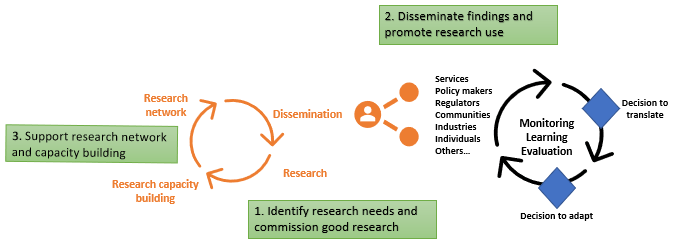Research can be defined as a creative and systematic way to generate knowledge, a process of collecting and analysing data to increase understanding, or investigation or experimentation of new facts.
A key function of research on gambling harm is to build a body of good quality evidence on gambling, its impact on people and community, and ways of preventing and minimising harm on individuals, communities, and at the population level.
To support the goal of harm prevention and minimisation, it is important that research projects commissioned under the gambling harm strategy will:
- have a strong focus on supporting knowledge to action (K2A) – providing research findings and actionable insights that can be translated into practice to support gambling harm prevention and minimisation
- have good quality research design, be relevant to a New Zealand context, and be mindful of the position of power in research (that is – who is deciding what?).
The current gambling harm research programme takes a longer-term strategic approach. It recognises the rapid change in the gambling space (for example, online gaming and eSports), and the importance of building New Zealand relevant baseline data (for example, a gambling prevalence survey) and insights for future evidence needs.
The research programme also supports dissemination of findings, promotes research use, and encourages research network and capacity building.
 Click to enlarge | Text description
Click to enlarge | Text description
The diagram includes three functions.
- Identify research needs and commission good research.
- Disseminate findings and promote research use.
- Support research network and capacity building.
There are two cycles in the diagram.
The Monitoring, Learning, Evaluation cycle includes:
- services, policy makers, regulators, communities, industries, individuals and others
- decision to translate
- decision to adapt.
The other cycle includes:
- dissemination (connects to services, policy makers, regulators, communities, industries, individuals and others)
- research
- research capacity building
- research network.
Research programme 2022/23-2024/25
The current gambling harm research programme takes a longer-term strategic approach. It recognises the rapid change in the gambling space (for example, online gaming and eSports), and the importance of building New Zealand relevant baseline data (for example, a gambling prevalence survey) and insights for future evidence needs.
The table below shows research priorities and examples of research topics that support current strategy priorities. Research projects commissioned will be listed under Current research projects.
| Research priorities supporting the Strategy to Prevent and Minimise Gambling Harm 2022/23–2024/25 | ||||
| Qualitative and quantitative longitudinal, prevalence, or multi-source data providing a more holistic and cross-sector view of gambling harm and related health and other issues | Studying patterns and impacts of gambling and online gambling on young people /rangatahi | Understanding the relationship between video gaming and gambling | Assessing barriers to equitable service access, quality, and outcomes, especially for people who are more likely to experience inequity, for example Māori, Pacific peoples, Asians, youth, new migrants, older people, and people with disability. | Research into preventing and reducing gambling relapse and treatment dropouts |
| Examples of research topics supporting each research priority | ||||
|
1. Patterns of coexisting problems and efficacy of transdiagnostic treatments in addressing comorbidities for people with gambling addiction and harm. 2. What’s the journey to gambling addiction and recovery from a Lived Experience perspective that can be learned for the purpose of harm prevention and minimisation... 3. Exploring the possibility of a data monitoring framework for gambling harm with publicly available data, such as health surveys, the IDI, and DIA/Lotto/TAB public data. |
4. Review of international research evidence on online gambling related harms to support a public health approach to preventing and minimising gambling harm. 5. Perception and effectiveness of current public health measures on children, adolescents, and young adults. 6. Contributing and preventative factors for moving from eSport participation for leisure to addiction. 7. Assessment of social media and online influencers and their role in promoting gaming and gambling among young people in Aotearoa. |
8. Review of international research evidence on the migration or concurrence between video gaming and gambling for people experiencing harm from either activity to support a public health approach to preventing and minimising gambling harm. 9. Contributing factors for developing gambling addiction relating to moving from skin gambling to betting with real money. 10. Exploring publicly accessible social media conversations on gambling and video gaming and needs for support. |
11. Culturally responsive service and support models and outcome for people who are more likely to experience barriers to equitable service access, quality, and outcomes. For example, for Māori, Pacific communities, Asian communities, youth, migrants, LGBTQIA+, older people, or people with disability. 12. Measuring the burden of gambling harm on whānau and significant others and exploring provision of support required for this population. 13. Understanding whānau centred practice, when it is useful, for who, how, what are the challenges, and how it supports recovery. 14. Gambling harm among older people: reasons, impact, and support. |
15. Exploring the use and effectiveness of online blockers in supporting the treatment journey among people with different levels of gambling harm. 16. Similarities and differences in the experience of lapse and relapse between people experiencing land-based and online gambling harm, and effective preventing strategies. 17. Experience of people using venue and/or online exclusion to reduce or stop their gambling. 18. Understanding gambling harm treatment dropouts – reasons, consequences, and solutions that support recovery. |
